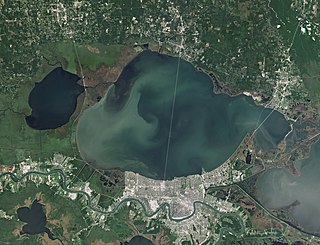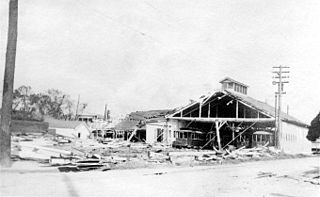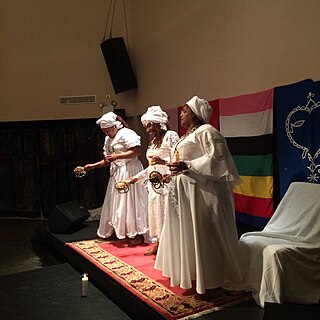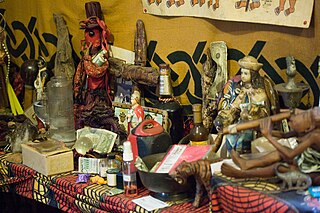
New Orleans is a consolidated city-parish located along the Mississippi River in the southeastern region of the U.S. state of Louisiana. With a population of 383,997 according to the 2020 U.S. census, it is the most populous city in Louisiana and the French Louisiana region; the third-most populous city in the Deep South; and the twelfth-most populous city in the Southeastern United States. Serving as a major port, New Orleans is considered an economic and commercial hub for the broader Gulf Coast region of the United States.

Ponchatoula is the second-largest city in Tangipahoa Parish, Louisiana. The population was 6,559 at the 2010 census and 7,545 at the time of the 2020 population estimates program.

Lake Pontchartrain is an estuary located in southeastern Louisiana in the United States. It covers an area of 630 square miles (1,600 km2) with an average depth of 12 to 14 feet. Some shipping channels are kept deeper through dredging. It is roughly oval in shape, about 40 miles (64 km) from west to east and 24 miles (39 km) from south to north.
Marie Catherine Laveau was a Louisiana Creole practitioner of Voodoo, herbalist and midwife who was renowned in New Orleans. Her daughter, Marie Laveau II, also practiced rootwork, conjure, Native American and African spiritualism as well as Louisiana Voodoo and traditional Roman Catholicism. An alternate spelling of her name, Laveaux, is considered by historians to be from the original French spelling.

Manchac is an unincorporated community in Tangipahoa Parish, Louisiana, United States.
KLRZ is a radio station licensed to Larose, Louisiana. Owned by Coastal Broadcasting, KLRZ targets both New Orleans and the Tri-Parishes area.

The New Orleans Hurricane of 1915 was an intense Category 4 hurricane that made landfall near Grand Isle, Louisiana, and the most intense tropical cyclone during the 1915 Atlantic hurricane season. The storm formed in late September when it moved westward and peaked in intensity of 145 mph (233 km/h) to weaken slightly by time of landfall on September 29 with recorded wind speeds of 126 mph (203 km/h) as a strong category 3 Hurricane. The hurricane killed 275 people and caused $13 million in damage.

The New Orleans Public Library (NOPL) is the public library of the city of New Orleans, Louisiana, United States. Succeeding earlier libraries in the city, it opened in 1897. Three branches were added by 1908. Carnegie library branches were added in 1911 and 1915. By 2005 a dozen branches were open. The main library is listed on the National Register of Historic Places.

A manbo is a priestess in the Haitian Vodou religion. Haitian Vodou's conceptions of priesthood stem from the religious traditions of enslaved people from Dahomey, in what is today Benin. For instance, the term manbo derives from the Fon word nanbo. Like their West African counterparts, Haitian manbos are female leaders in Vodou temples who perform healing work and guide others during complex rituals. This form of female leadership is prevalent in urban centers such as Port-au-Prince. Typically, there is no hierarchy among manbos and oungans. These priestesses and priests serve as the heads of autonomous religious groups and exert their authority over the devotees or spiritual servants in their hounfo (temples).
Hexing a Hurricane is a 2006 documentary film about the effect of Hurricane Katrina on New Orleans. It has been billed as the "First Katrina documentary" released by a New Orleanian. The film was directed by Jeremy Campbell and distributed by the National Film Network. The film's score was orchestrated by New Orleans artist Eric Laws.

Sallie Ann Glassman is an American practitioner of Vodou, a writer, and an artist. She was born in Kennebunkport, Maine and is a self-described "Ukrainian Jew from Maine", and a former member of Ordo Templi Orientis.

Interstate 55 (I-55) is a part of the Interstate Highway System that spans 964.25 miles (1,551.81 km) from LaPlace, Louisiana, to Chicago, Illinois. Within the state of Louisiana, the highway travels 66 miles (106 km) from the national southern terminus at I-10 in LaPlace to the Mississippi state line north of Kentwood.

Louisiana Voodoo, also known as New Orleans Voodoo, is an African diasporic religion and magic tradition that originated in Louisiana. It arose through a process of syncretism between the traditional religions of West Africa, the Roman Catholic form of Christianity, and Haitian Vodou. No central authority is in control of Louisiana Voodoo, which is organized through autonomous groups.

U.S. Highway 51 (US 51) is a part of the United States Numbered Highway System that spans 1,277 miles (2,055 km) from LaPlace, Louisiana to a point north of Hurley, Wisconsin. Within the state of Louisiana, the highway travels 69.12 miles (111.24 km) from the national southern terminus at US 61 in LaPlace to the Mississippi state line north of Kentwood.
Ruddock is a ghost town in St. John the Baptist Parish, Louisiana, United States. Ruddock was located on an isthmus between Lake Maurepas and Lake Pontchartrain, 10 miles (16 km) north-northeast of LaPlace.
Julia Jackson was a Louisiana Voodoo practitioner from New Orleans.

The Battle of Ponchatoula was a battle in Ponchatoula, Louisiana, and Ponchatoula Creek at the onset of the Vicksburg Campaign during the American Civil War. Fought from March 24 to March 26, 1863, the battle was part of an offensive campaign waged by the Union's 6th Michigan, 9th Connecticut, 14th Maine, 24th Maine, 165th New York Zouaves, and 77th New York infantry against Confederate troops to capture Ponchatoula for the Union and destroy the town's railroad bridge. This was ultimately a failure by the Union, as the outcome of the battle led to the Confederates regaining control of Ponchatoula.
Mary Oneida Toups was an American occultist known as the "Witch Queen of New Orleans". Toups was the founder and high priestess of the Religious Order of Witchcraft, which was the first coven to be chartered as an official religious organization in the state of Louisiana. In 1975 she published an instructional occultist book titled Magick High and Low.
Malvina Latour was an American Voodoo practitioner and disciple of Marie Laveau in New Orleans.

Portrait of a Creole Woman with Madras Tignon is an oil painting traditionally attributed to George Catlin. It is best known from a c. 1915 copy made by Frank Schneider, an art restorer working for the Louisiana State Museum. The portrait was historically known as Portrait of Marie Laveau as it was presumed to depict Louisiana Voodoo priestess Marie Laveau. Long thought to be lost, the painting resurfaced in 2022 when it was sold at auction for US$984,000.















